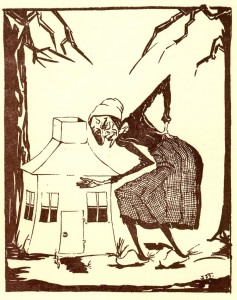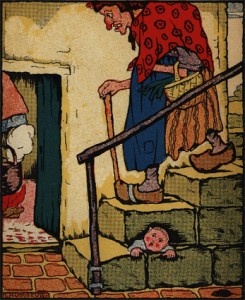Witchcraft Dutch
Toverij artikelen
– Betoverd en behekst, Neerlands volksleven 33 (1983): 168-190.
– Van heksenprocessen naar toverij, Volkskundig bulletin 12 (1986): 2-30.
Summary: From witch trials to witchcraft.
Until recently the study of historical witchcraft in the Netherlands was dominated by Scheltema’s paradigm. Local historians published accounts of accidently discovered witch trials mainly to show their sharp contrast with nineteenth- and twentieth-century rationality. They took little interest in the social and cultural or judicial and economic contexts of witchcraft. Hence their answer to the question of why witch trials were stopped in the early seventeenth century – a comparatively early date – are unsatisfactory.
This essay draws attention to the changing vocabulary of witchcraft, from the different uses of the term ‘toverij’ , which denoted ‘white’ as well as ‘black’ witchcraft, to the now prevailing word ‘hekserij’. It also stresses the necessity to consider the local and regional judicial practices, consisting of witch trials, trials of cunning men and women, and slander trials. Examples of the last two categories, dating from the seventeenth and eighteenth centuries, are given to indicate a possible continuity in content despite differences in interpretation and context. Folklorists in the nineteenth and twentieth centuries, by placing witchcraft in a ‘civilizing’ perspective, thereby focused mainly on witchcraft as legend. Their texts, as well as those from judicial and ecclesiastical sources, should be augmented with information about their contexts. Together, they could be used to generate systematic local and regional studies of the cultural and social production and reception of witchcraft and witchcraft accusations, extending from the Middle Ages to the present days.
– Meppelse toverij aan het eind van de achttiende eeuw, Volkskundig bulletin 12 (1986): 203-240.
English version in: Beyond the Witch Trials (2004).
– Heksenjacht als discussie: Nederlandse wetenschappers over Europese heksenvervolgingen, Volkscultuur: tijdschrift over tradities en tijdsverschijnselen 4.1 (1987): 57-74.
– Undersyk nei tjoenderij yn Fryslân, It beaken 49 (1987): 105-120.
– Doodstraf in Drenthe? Zestiende-eeuwse juridische procedures inzake toverij, in: Marijke Gijswijt-Hofstra & Willem Frijhoff (red.), Nederland betoverd. Toverij en hekserij van de veeriende tot in de twintigste eeuw. Amsterdam: De Bataafse Leeuw (1987): 117-123.
– Vier eeuwen Friese duivelbanners, in: Nederland betoverd (1987): 222-231.
English translation in: Witchcraft in the Netherlands (1991).
– (met Hans de Waardt), `Het is geen zonde een kwaad mens ter dood te brengen’. De berechting van toverij tijdens de regering van hertog Karel van Egmond, in: Nederland betoverd (1987): 14-25.
English translation in: Witchcraft in the Netherlands (1991).
– (met Freek Pereboom), Betichting en vermaning. Toverij in het land van Vollenhove, zeventiende eeuw, in: Nederland betoverd (1987): 107-116.
English translation in: Witchcraft in the Netherlands (1991).
– Duivelbanners in de Noordelijke Friese Wouden, 1860-1930, Volkskundig bulletin 14 (1988): 159-187.
Summary: Witchdoctors in the northern ‘Friese Wouden ’, 1860-1930.
Witchdoctors (cunning or wise men; dutch: ‘duivelbanners’) played an important role in witchcraft tradition. To emphasize their position and to trace possible changes, the popularity of witchdoctors in the north-eastern part of the province of Frisia during the period 1860-1930 is examined and compared with the popularity of other non-official healers in the same area.
Legend texts (i.e. , personal narratives about superstition) proved a valuable source, but for chronological purposes in particular their contents had to be augmented with information provided by newspaper articles and death certificates. After considering the quantitative, spatial, temporal and socio-cultural aspects of the popularity of these witchdoctors, three categories are discerned: local, regional and supra-regional popularity. It appears that the ranges of influence of the various witchdoctors in
these three categories were separated in space and time. The high popularity of (sporadically witchcraft curing) unofficial healers from the beginning of the twentieth century onwards forms a smooth transition from the popularity of supra-regional witchdoctors in the second half of the nineteenth century. Strictly local witchdoctors were the last to disappear and their successors (often relations) mainly restricted themselves to curing non-witchcraft inflicted diseases.
An explanation for these changes, as well as for the choices of individual clients, is only hinted at. Future research on the socio-cultural background of the clients might shed more light on the matter.
– De roman als reactie: het Staphorster toverijgeval van 1839. Amsterdams sociologisch tijdschrift 15 (1988): 93-107.
Summary: The novel as reaction; the 1839 Staphorst witch case.
In the social sciences novels are increasingly used as source material. This article examines the problem of reliability of this kind of source by comparing official documents with an anonymous novel – both texts dealing with the same witch case. While the records focus on maltreatment and hardly mention witchcraft at all, the theme of the novel (‘falling in love with a girl from a family of witches’) belongs to a literary tradition.
Notwithstanding the similarities in content between both texts, it is concluded that in terms of empirical information the novel only has a signalling value. It contains no extra insights and makes itself redundant as soon as other, non-literary, sources are discovered. An alternative approach is proposed by considering a novel as one of the many conflicting
views about a historical event.
– Een duivelbanner in Wolvega? Volkscultuur 5.3 (1988): 30-39.
– Heksengeloof: toverij en religie in Nederland tussen 1890 en 1940, Sociologische gids 36 (1989): 245-266.
Summary: Witch belief; witchcraft and religion in the Netherlands between 1890 and 1940.
Although recent European witchcraft has been a blind spot for most anthropologists and historians, it has drawn the attention of folklorists. Despite the mass of material collected by the latter, their witchcraft texts contain some serious gaps. The constitutive link between witchcraft and religion is one factor that has not been acknowledged generally.
This article hypothesizes that there is a close relation between orthodox Calvinism and witchcraft. Since direct proof is lacking (the religion of those who interpreted illness in terms of witchcraft is not known) it is offered in a roundabout way. While collecting witchcraft texts, folklorists have used the negative category of superstition, i.e. everything not accepted as an official belief. In practice, however, their informants sought
help against witchcraft from specialists, among them Roman Catholic priests. One of the most public instances of witchcraft was the boiling of a live black hen in order to draw the witch to her alleged victim and compel her to withdraw the curse. Another way to recognize a witch involved the rotation of the Bible. These practices coincided geographically with orthodox Calvinism. Loose remarks from various regions even point
to a direct link: orthodox Calvinists found justification in the Bible for the existence of witches. As their own religion offerd no counter charms, they had to apply to Roman Catholics or to resort to violence.
It seems likely that similar relations between witchcraft and orthodox Calvinism can be found in other parts of Europe.
– Specialistes in geluk. Waarzegsters in Groningen, Friesland, Drenthe en Overijssel in de 19de en het begin van de 20ste eeuw, Etnofoor 2.2 (1989): 71-90.
– Tovermeesters in Nijmegen? Volkscultuur 6.3 (1989): 37-50.
– (met Hans de Waardt), De regels van het recht. Aantekeningen over de rol van het Gelderse Hof bij de procesvoering inzake toverij, 1543-1620, Bijdragen en mededelingen Gelre 80 (1989): 24-51.
– (met Hans de Waardt), Das Vordringen der Zaubereiverfolgungen in die Niederlande: Rhein, Maas und Schelde entlang, in: Andreas Blauert (Hg.), Ketzer, Zauberer, Hexen. Die Anfänge der europäischen Hexenverfolgungen. Frankfurt am Main: Suhrkamp (1990): 182-216.
– Termen van toverij. De veranderende betekenis van toverij in Noordoost-Nederland tussen de 16de en 20ste eeuw. Nijmegen: SUN (1990).
– Huizers historische heksen. Een commentaar, Focaal 13 (1990): 120-126.
– Typen van toverij, in: Peter te Boekhorst, Peter Burke & Willem Frijhoff (red.), Cultuur en maatschappij in Nederland 1500-1850. Een historisch antropologische benadering. Amsterdam/Meppel: Boom (1992): 319-363.
– De kattendans, Volkskundig bulletin 25 (1999): 260-271
Summary: The Dance of the Cats.
Research into Dutch folk legends has been restricted to collecting and indexing; no analysis was carried out. Han Voskuil, especially, believed the available legends had very limited use because they were in the main decontextualized manifestations of superstition. In defiance of this opinion in this article a less rigid genre classification is suggested. Legends about meetings with cats are presented to show how function and meaning can be reconstructed. Referring to unbound, sexually active women, these legends appear to have been told by men to boys as an anecdote, warning and initiation into manhood. It is likely that they were primarily told at communal gatherings and that they died out when these events disappeared.
– Metamorfosen of metaforen? Hoe mensen in dieren veranderen, Raster 95 (2001): 68-81.
German version: in Tierverwandlungen (2011).
– Het magisch perspectief. Toverij in westelijk Nederland, 1850-1925, Tijdschrift voor Geschiedenis 114 (2001): 377-393.
English version: in Witchcraft Continued (2004).

